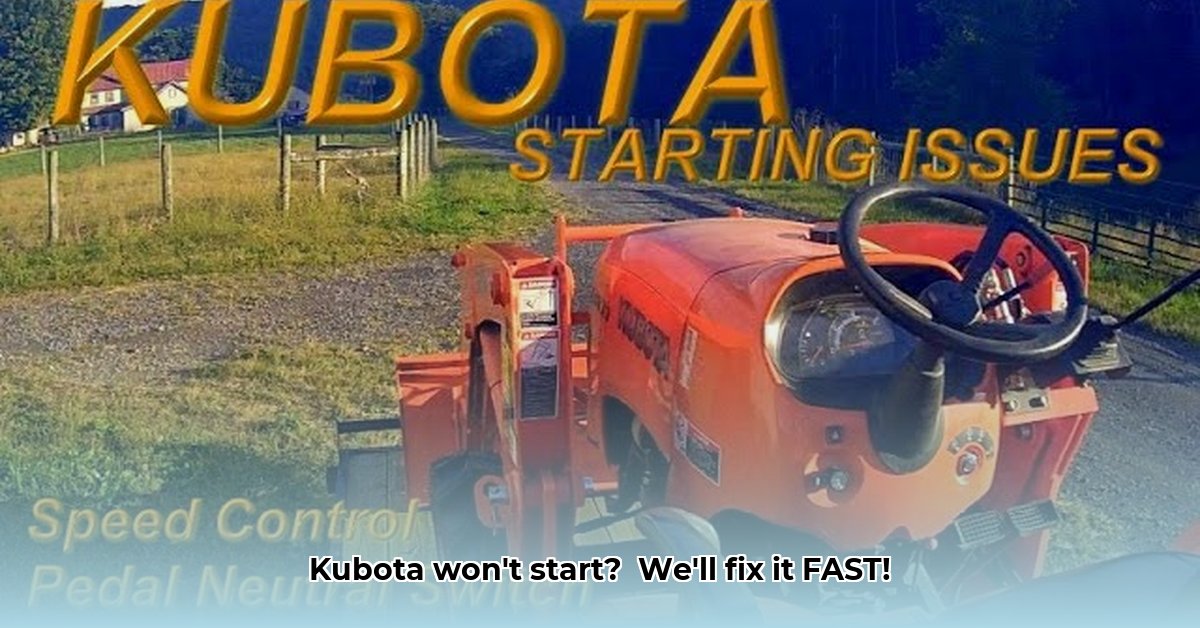
Your Kubota tractor refusing to start? This guide provides a step-by-step approach to troubleshooting common issues, helping you get back to work quickly. Whether you're a seasoned operator or a novice, we'll walk you through the process, from simple checks to more complex diagnostics. For detailed battery charging instructions, see this helpful guide.
1. Battery and Electrical System: The Usual Suspects
A dead or weak battery is the most frequent culprit. Let's start here. Does your tractor even attempt to crank?
Check Battery Voltage: Use a multimeter (a device that measures voltage; available at most auto parts stores) to check the battery's voltage. A reading below 12.2 volts indicates a weak battery needing a charge or replacement.
Did you know that a slightly corroded battery terminal can significantly reduce starting power?
Inspect Battery Terminals and Cables: Examine the battery terminals for corrosion (that green, powdery substance). Clean them thoroughly with a wire brush or terminal cleaner. Also, ensure all cable connections are tight and secure. Always disconnect the negative (black) terminal first before working on any electrical components.
Fact: Clean connections reduce resistance and improve electrical flow.
Test the Starter Solenoid: A clicking sound when you turn the key often points to a faulty starter solenoid or a low battery voltage. Use your multimeter to test the solenoid's continuity (check your owner's manual for model-specific testing procedures).
"A malfunctioning solenoid is a common cause for no-starts," says John Miller, Certified Kubota Technician at Miller's Tractor Repair.
Inspect the Ignition Switch: A malfunctioning ignition switch can prevent current flow to the starter. Visually inspect the switch for any damage. If unsure, consult a mechanic.
2. Fuel System Malfunction: Ensuring Fuel Delivery
If the electrical system checks out, let's investigate the fuel supply. No fuel means no combustion.
Fuel Level Check: This may sound obvious, but a low fuel level is a surprisingly common reason for starting problems.
Fuel Filter Inspection: A clogged fuel filter restricts fuel flow. Inspect the filter (location varies by model; check your owner's manual). Replace it if it's dirty or damaged. Regular filter replacement is crucial preventative maintenance.
Question: How often do you replace your Kubota's fuel filter?
Fuel Lines and Connections: Examine the fuel lines for leaks, cracks, or blockages. Tighten any loose connections.
3. Safety Switches: Preventing Unintended Starts
Kubota tractors often feature safety switches that prevent starting unless certain conditions are met (seat occupied, PTO disengaged, brake/clutch depressed). Check if these are engaged correctly. A disengaged safety switch is a surprisingly overlooked reason for starting failures.
*"Always check your safety switches, it's a simple fix that saves time and prevents accidents," advises Susan Lee, Agricultural Safety Specialist at the National Farm Safety Association."*
4. Deeper Diagnostics: When Troubleshooting Gets Tough
If the above steps don't resolve the issue, the problem might require more advanced diagnostics.
Starter Motor Testing: If the engine doesn't crank, the starter motor might be faulty. Testing this requires some mechanical skill and specialized tools.
Engine Compression: Low engine compression can prevent starting. Testing requires a compression gauge and is best left to a qualified mechanic.
Other Mechanical Issues: Severe issues like low oil pressure, a broken timing belt, or internal engine damage are more complex and require professional attention.
5. Model-Specific Considerations
The specific troubleshooting steps and component locations may vary significantly depending on your Kubota tractor's model (e.g., L-series, M-series, BX-series). Always consult your owner's manual for model-specific information, diagrams, and safety procedures. Your owner's manual contains crucial information tailored to your specific machine.
Key Takeaways:
- Most starting problems are easily fixed. Begin with a systematic approach, starting with the simplest checks.
- Preventative maintenance (like regular fuel filter changes) significantly reduces the chance of future issues.
- If you're unsure about any step, consult a qualified mechanic. Your safety is paramount.